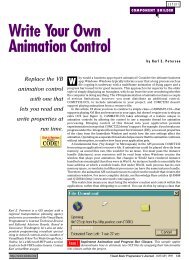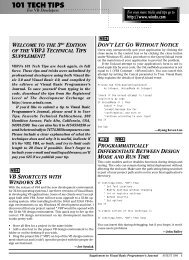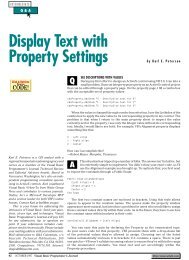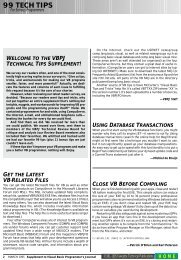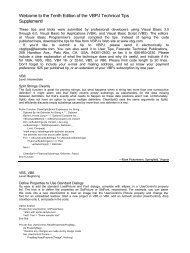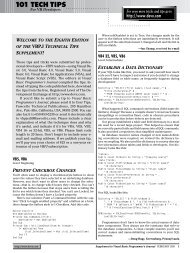101 Tech Tips - Visual Studio Magazine - One-Stop Source Shop
101 Tech Tips - Visual Studio Magazine - One-Stop Source Shop
101 Tech Tips - Visual Studio Magazine - One-Stop Source Shop
- No tags were found...
You also want an ePaper? Increase the reach of your titles
YUMPU automatically turns print PDFs into web optimized ePapers that Google loves.
<strong>101</strong> TECH TIPSFor <strong>Visual</strong> <strong>Studio</strong> DevelopersVB.NETLevel: IntermediateArrays With Non-Zero Lower BoundsIn VB.NET, you can use the System.Array class to create an arraywith non-zero lower bounds. To do this, use the System.Array.-CreateInstance method: Array.CreateInstance(Type, Lengths( ),LowerBounds( ) ).If the array you create has two or more dimensions, you cancast it to a normal array. This example creates an array of stringsequivalent to Dim sArray(5 To 14, 8 To 27):Dim Lengths() As Int32 = {10, 20}Dim LowerBounds() As Int32 = {5, 8}Dim myArray As Array = _Array.CreateInstance(GetType(String), _Lengths, LowerBounds)' have to declare the array with the correct' number of dimensionsDim sArray(,) As String = CType(myArray, _String(,))Dim i As Int32For i = 0 To sArray.Rank - 1Console.WriteLine _("dimension {0} , LowerBound = {1}, _UpperBound = {2}", _i, sArray.GetLowerBound(i), _sArray.GetUpperBound(i))NextNote: You cannot cast to single dimension arrays because VB.NETcreates them as vectors.VB3, VB4, VB5, VB6Level: Beginning—Bill McCarthy, Barongarook, Victoria, AustraliaCopy Filenames to a ClipboardFile hierarchies are becoming more complex and file paths longeras the capacity of hard drives increases. There are still manyoccasions, however, when you can’t browse to identify a file to beused—for example, when entering a constant in VB source. Normally,there is no alternative but to type in the path—this can beboth tiresome and error-prone.The solution: Create a new Standard EXE project, delete thedefault form (Form1), and add a module (Module1 by default).Type this code into Module1:Sub Main()Clipboard.SetText Command$End SubUnder Project | Project Properties, set the Startup Object toSub Main. Give the project a suitable name (for example, filename)and create the executable (in this case, filename.exe). Create ashortcut to the executable on your desktop. When the name of fileis required, browse using Explorer or My Computer. Drag the fileand drop it onto the filename shortcut. The full path of the file isnow on the clipboard and you can paste it as necessary.This works because dropping an object onto a program orits shortcut starts it with the name of the object in the commandline. The program merely reads the command line and puts it ontothe clipboard.—M.J. Roycroft, Caversfield, Bicester, Oxfordshire, EnglandVBSLevel: BeginningFormat Strings in Proper CaseVBScript does not support the StrConv( ) function, which is usefulto format strings in proper case. Use this algorithm to help you:Public Function StrConv( _ByVal psString, ByVal plFormat) 'As StringDim lsString 'As StringDim laString 'As StringDim liCount 'As IntegerDim lsWord 'As StringConst vbProperCase = 3lsString = psStringSelect Case plFormatCase vbProperCaselsString = LCase(lsString)laString = Split(lsString)For liCount = 0 To UBound(laString)lsWord = laString(liCount)If Len(Trim(lsWord)) > 0 ThenlsWord = UCase(Left(lsWord, 1)) & _Right(lsWord, Len(lsWord) - 1)laString(liCount) = lsWordEnd IfNext liCountlsString = Join(laString)Case ElseEnd SelectStrConv = lsStringEnd FunctionThe sample call StrConv("the pHillIes wiLL PrevaiL", 3) returns thestring 'The Phillies Will Prevail'.You can use the same name for the corresponding <strong>Visual</strong> Basicfunction to facilitate easy adoption of the native version should itever be supported in future releases of VBScript. If desired, youalso can add support for the other StrConv formatting options.VBScript doesn’t currently support the Mid statement (as opposedto the Mid function) either, or you could rewrite thisalgorithm more efficiently using that.VB3, VB4, VB5, VB6Level: Beginning—Brian Egras, PhiladelphiaAdd Nonkeyboard Characters to Your ProjectWhen creating a project or Web page, you sometimes need to usecharacters not included on your keyboard—for example, ®, £, §, ©,1/ 4, 1 / 2, 3 / 4, and so on. Sure, you can use the Chr$( ) function andcreate any single character by ASCII code, but you can accomplishthis task in a simpler way.Hold down the Alt key on a keyboard. Using the numerickeypad, not the top row numbers, Type 0, then the three-digit ASCIIcode of the character. Now release the Alt key. For example, toenter the copyright symbol into a string literal, type Alt-0169.You’ll see the designated character on the screen without anyadditional coding functionality. Easy, isn’t it? All you need to knowis the ASCII code of the character you want to use. You can look thisup in the MSDN Library under Index: ASCII character set (CharacterSet 128-255), or—easier still—fire up the Character Map appletthat comes with Windows.Be aware that although most text fonts follow mostly standardcharacter mapping, deviations are common, and all bets are off ifyou end up with a symbol font.—Alex Grinberg, Holland, Pa.24 Supplement to <strong>Visual</strong> <strong>Studio</strong> <strong>Magazine</strong> SEPTEMBER 2001



